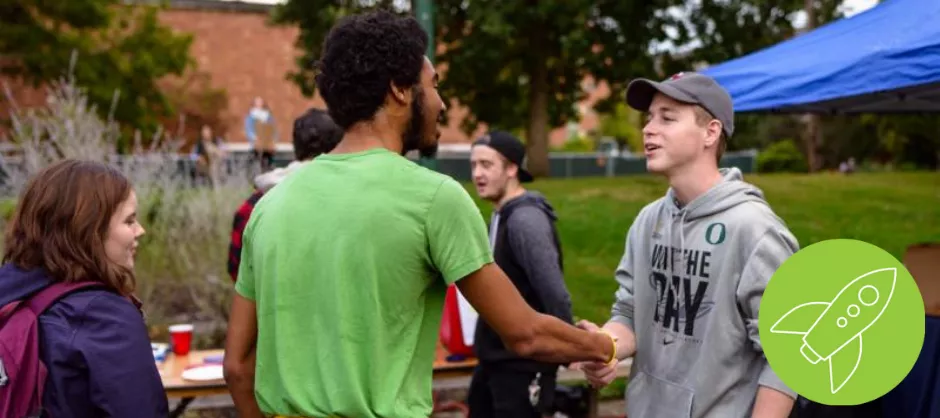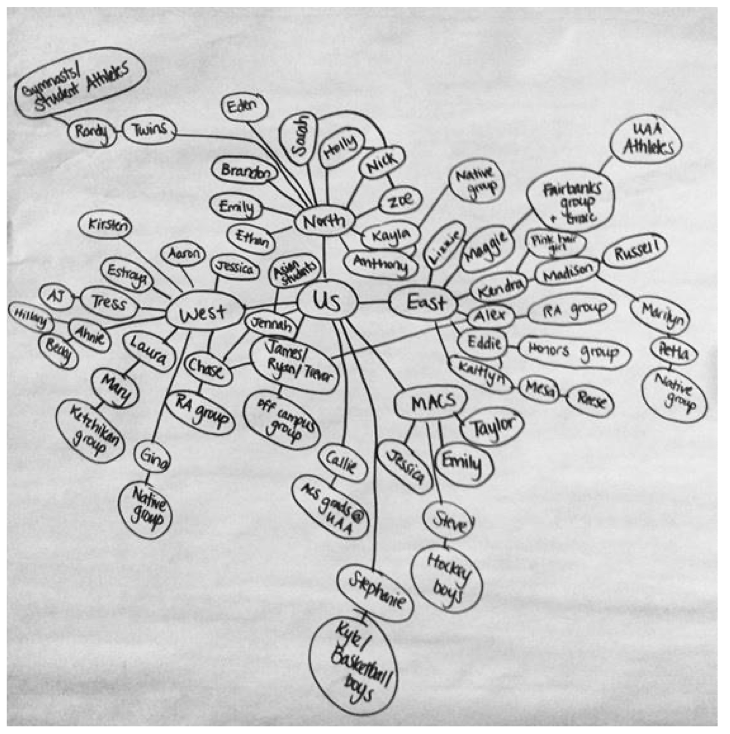
How to encounter God and explore shared networks
God has granted you and the people in your small group overlapping connections to common friends, social networks, academic departments, and people you see regularly. This resource will help you explore these shared social networks and encounter God together to discern what to do next.
Network mapping is a great activity for individuals, but it is also a powerful exercise for small groups to do together. This helps your small group to communally explore what God is doing.
Step 1: Create a Network Map
All you need is a blank piece of paper and pens (or if you have them, a few colored pens) or a whiteboard. Write your names in the middle. Then name the places (outside your Christian group or church) where you interact with people on a regular basis. Next, start writing down names of people you know around each of those places. (See a real example below)
If you’re feeling stuck, think through your week from the time you wake up to the time you got to campus and your classes to anything you do before coming home—who are you with? Who do you know? Walk through each day of your week to try to fill out your networks.
Usually, after ten minutes of drawing your relational networks, you'll be surprised by how many people you know in each of the places where you frequently connect. It is generally easy for a group to come up with over 100 names. Few things can so quickly reveal your group's immediate mission field!
Step 2: Pray
Next, spend some time praying by name for the people on your network map. Do this as a whole small group or in pairs. Ask God for God's kingdom to come and God's will to be done on earth as it is in heaven for these people.
Praying communally is important because we are trusting God has brought your small group together and it's possible he may want to speak to someone in your small group about one of your friends on your network map as well as to you.
Step 3: Discern
When praying and discerning where to take some next steps in your network map, pay attention to a rise in compassion in your heart for anyone on your map or images, scripture or any general sense of being drawn to someone. This is also a time God may remind you of a conversation you had with someone that at the time didn't seem significant, but now seems to be an indication of their spiritual openness. Write down these impressions.
Sample questions to ask God when you pray over your networks:
- What do you want us to see here?
- Why have you placed these particular people in our lives?
- Is there a place or people group you want to send us to?
- What is your vision for these people? What do you want to see happen among them?
- What have you given us that we should pass on to them?
- What do we need to do to prepare ourselves? Is there an attitude, skill or knowledge we need to be effective in this? Is there something we need to repent of or let go?
Tip: The Five Thresholds (1 - trust, 2 - curiosity, 3- open, 4 - seeking, 5 - follower) can be a helpful tool to gauge where each friend is on their spiritual journey. As you pray, you can take your best guess and jot down a 1-5 on your network map next to their name.
Interested in learning more about the Five Thresholds? Find more here.
Step 4: Decide Together
The next step for your small group is to decide with God's help where to focus your energy.
Our God is a sending God. All of our activity to engage with Christian or seeking friends doesn't rest on us but on the God who sent himself in Jesus to us to show us how we are sent in the same way. Jesus says in John 20:21 as he commissions his followers, “Peace be with you. Just as the Father has sent me, I also send you.” Just as we abide in Jesus and are rooted in him, we are at the same time sent—we are "sent ones."
When you finish praying over your network maps and have named some friends God is leading you to pay attention to, compare this with other people in the group. Spend some time observing your networks and looking for connections. Here are some things to notice:
- Do a few of you in the small group know people in the same network? This could be a connection to the soccer team or a club on campus like the Asian American Pacific Islander cultural club (AAPI) or people all in the same class or department, or a group of people all interested in something similar like poetry or rock climbing.
- As you look at the friends you feel called to, are many of them near a certain threshold? For example does your group have a lot of seeking friends who are at Threshold 1 and who are building trust with Christians? Or, perhaps Threshold 2 where we are watching for their spiritual curiosity to grow?
- If you don’t see any discernible connections between your network maps and the friends you feel called to and that's ok. Take some time to pray as a group over some of the friends or groups on your maps and try to decide on a few friends or a new group your small group will pursue together, even if it's only connected to one person in the group.
Sample Network Map

Special thanks to Shawn Young, National Director of Planting, who has written about the activity of network maps.

This resource has been tested and approved by InterVarsity’s National Strategy & Innovation team for campus ministry. Explore more resources by visiting the Accelerated Small Group Leadership Collection.

